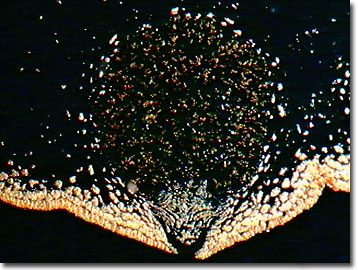Darkfield Digital Image Gallery
Fucus Male Conceptacle
Fucus, better known as kelp or seaweed, is a genus of exclusively-marine brown macroalgae in the family Phaeophyceae. The phytopigment fucoxanthin masks the natural green of the chlorophylls in these multicellular intertidal and subtidal plants.

Known also as wracks, the Fucus brown seaweeds are always diploid and meiosis takes place before the gametes are formed. The reproductive organs of the macroalgae consist of receptacles and conceptacles. Gamete production takes place in specialized crypt-like structures known as conceptacles. The conceptacles are carried in receptacles, which are swollen areas found at the tips of the plants. While some species of wracks are dioecious, others feature both types of sexual organs on one plant and are classified as monoecious. To add to the diversity of reproductive strategy featured by this genus of brown algae, some of the monoecious species have both sexes in a single conceptacle while others contain them in separate organs. The conceptacles for the male reproductive organs are lined with antheridiophores, which are branched and feature inflated, terminal antheridia on their branches. The antheridia are the sites of meiosis, forming 64 to 128 biflagellated male gametes that are referred to as antherozoids. The male and female gametes are usually released into the water during a rising tide with the female eggs emitting a potent volatile hydrocarbon compound (fucoserraten), which acts as an attractant for the mobile male antherozoids. The fertilized egg settles onto the sediment and germinates as a new diploid thallus.
Known also as the medicinal seaweed or Fucus, species in this genus have the highest antioxidant activity of the edible seaweeds, most likely because of the fucoxanthin. As an extract, it is available as a dietary supplement and supports a thriving industry along Ireland's coasts. Brown algae, particularly members of this genus, are especially rich in iodine and including it in the diet is thought to possibly remedy some thyroid problems. In Japan, F. vesiculosus, easily recognized by its paired air bladders, is also used as a dietary preventative of breast cancer and reportedly reduces cholesterol levels and enhances the immune system.
Contributing Authors
Cynthia D. Kelly, Thomas J. Fellers and Michael W. Davidson - National High Magnetic Field Laboratory, 1800 East Paul Dirac Dr., The Florida State University, Tallahassee, Florida, 32310.
BACK TO THE DARKFIELD IMAGE GALLERY
BACK TO THE DIGITAL IMAGE GALLERIES
Questions or comments? Send us an email.
© 1995-2025 by Michael W. Davidson and The Florida State University. All Rights Reserved. No images, graphics, software, scripts, or applets may be reproduced or used in any manner without permission from the copyright holders. Use of this website means you agree to all of the Legal Terms and Conditions set forth by the owners.
This website is maintained by our
Graphics & Web Programming Team
in collaboration with Optical Microscopy at the
National High Magnetic Field Laboratory.
Last Modification Friday, Nov 13, 2015 at 01:19 PM
Access Count Since September 17, 2002: 24489
Visit the website of our partner in introductory microscopy education:
|
|
